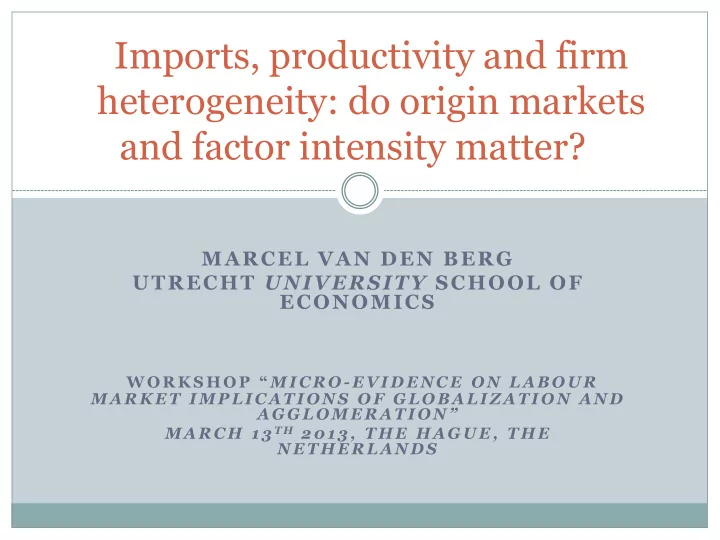

Imports, productivity and firm heterogeneity: do origin markets and factor intensity matter? MARCEL VAN DEN BERG UTRECHT UNIVERSITY SCHOOL OF ECONOMICS W O R K S H O P “ M I C R O - E V I D E N C E O N L A B O U R M A R K E T I M P L I C A T I O N S O F G L O B A L I Z A T I O N A N D A G G L O M E R A T I O N ” M A R C H 1 3 T H 2 0 1 3 , T H E H A G U E , T H E N E T H E R L A N D S
Introduction Stylized fact: internationally competing firms perform better than domestically operating firms Larger, more productive, more capital intensive, pay higher wages, invest more in R&D, higher probability of survival, etc. Most attention directed towards exporters; how about importers? Several mechanisms through which importing could foster productivity: Cheaper inputs Higher quality inputs (R&D intensive inputs from the technological frontier) More variety of differing quality (beneficial in case of imperfect substitutes) Spillover effects (learning from foreign suppliers) Characteristics of imports matter
Research questions Do Dutch importers outperform non-traders in terms 1. of productivity? ( Q1 ) Do characteristics of imports affect productivity? ( Q2 ) 2. Country of origin Factor intensity of imported goods Two hypotheses: Importing high quality goods from the technological frontier (relatively nearby) fosters productivity Importing from ‘difficult’ markets (relatively far away) requires higher productivity to overcome fixed cost of importing
Main findings Q1: importers more productive than non-traders but less than exporters and two-way traders Q2: Productivity… Increases in the number of import markets (by region and product) on which the firm is active incurring fixed cost for each additional market Increases in import share of nearby and developed regions Decreases in share of unskilled labor intensive products Increases in share of imported primary, high-tech, natural resource intensive and human capital intensive products from EU-15
Data
Firm trade type and productivity, The Netherlands 0.5 0.4 0.3 0.2 0.1 0.0 non-trader only imports only exports two-way trader total factor productivity labor productivity
Q2: impact of import characteristics? Analysis within subset of importers… conditional on being an importer given they are more productive (on average) than non-traders …for which full decomposition of imports is available: By origin country: 61,632 observations By product group: 38,164 observations By origin country and product group: 35,966 observations
By country of origin
Share of firms and # of import markets, The Netherlands 50% 40% 30% 20% 10% 0% 1 3 5 7 9 11 13 total factor productivity labor productivity
Productivity and # of import markets, The Netherlands, raw data; TFP left scale; LP right scale 35,000 100,000 30,000 80,000 25,000 60,000 20,000 15,000 40,000 10,000 20,000 5,000 0 0 1 3 5 7 9 11 13 total factor productivity labor productivity
Concentration of imports; % of firms with regional imports at least 50% and diversified firms Neighbors Developing Asia North America Diversified Advanced Asia M East N Africa South EU-15 Non-EU NW Europe North EU-15 Rest EU South America Sub-Sahara Af Rest Europe Australia NZ 0% 5% 10% 15% 20% 25%
Import origin and TFP; neighbours as reference minus coefficients & raw data North EU-15 raw data % South EU-15 all firms coefficient Non-EU NW Eur Australia NZ Rest EU Advanced Asia South America North America Rest Europe Sub-Sahara Af Developing Asia M East N Africa -0.1 0 0.1 0.2 0.3 0.4 0.5 0.6
By product type Factor intensity of imported good Aggregated into 5 product groups (following van Marrewijk, 2002) Primary products (e.g. live animals, oil, crops) Natural resource intensive products (e.g. leather and fur) Unskilled labor intensive products (e.g. clothing, footwear) Technology intensive products (e.g. ICT, chemicals) Human capital intensive products (e.g. cars, household equipment)
Import product type and TFP; primary products as reference; minus coefficients & raw data unskilled human cap nat resource coefficient raw data % high-tech -0.1 0.0 0.1 0.1 0.2 0.2 0.3 0.3 0.4 0.4
Productivity and # of regional product import markets, The Netherlands, raw data; TFP left scale; LP right scale 35,000 100,000 30,000 80,000 25,000 60,000 20,000 15,000 40,000 10,000 20,000 5,000 0 0 1 3 5 7 9 11 13 TFP LP
Import origin, product type and TFP; EU15 North, primary & high-tech as reference; minuscoefficients & raw data primary & high-tech EU15 South coefficient non-EU NW Europe raw data % developing ROW nat. resource & human cap EU15 North EU15 South non-EU NW Europe developing ROW unskilled labor int EU15 North EU15 South non-EU NW Europe developing ROW 0.0 0.1 0.2 0.3 0.4 0.5 0.6 0.7
Policy implications Productivity premium of importing seems to be mainly tied to imports from nearby regions Focus on BRIC-countries seems suboptimal strategy in this respect Empirical results seem largely consistent with focus on designated top sectors: product groups by factor intensity top sectors primary products agri-food, horticulture, energy technology intensive products high tech, chemicals, energy, life sciences & health human capital intensive products high tech, chemicals natural resource intensive products high tech
Thank you! Q U E S T I O N S A N D C O M M E N T S ? F O R F U R T H E R I N Q U I R I E S P L E A S E C O N T A C T T H E A U T H O R E - M A I L : M . R . V A N D E N B E R G @ U U . N L
Recommend
More recommend